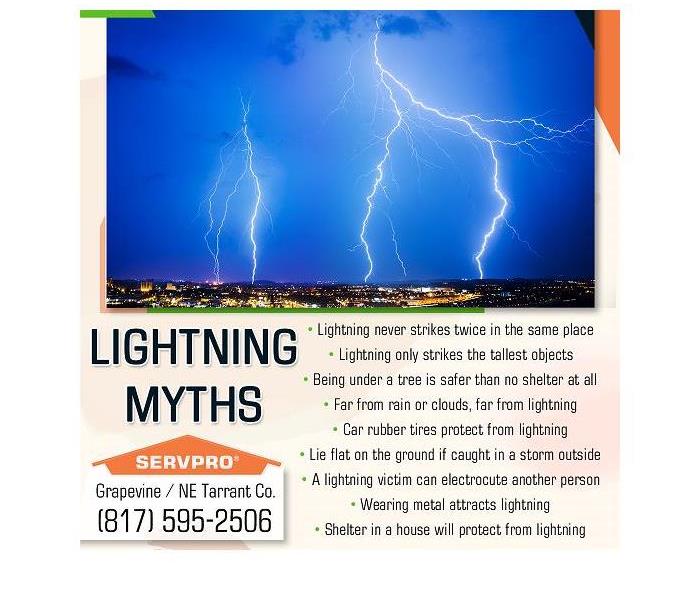Facts about lightning that can save lives
10/20/2021 (Permalink)
Blog summary: The SERVPRO article dismantles certain myths about lightning and shares important facts.
Busting some lightning myths
Every year, lightning detection systems in the United States monitor an average of 25 million strokes of lightning from clouds to ground during almost 100,000 thunderstorms. SERVPRO busts some myths that surround lightning and sheds light on facts below.
What is lightning?
Lightning is a giant discharge of electricity accompanied by a brilliant flash of light and a loud crack of thunder. The spark can reach over five miles in length, raise the temperature of the air by as much as 50,000 degrees Fahrenheit, and contain a hundred million electrical volts.
During a thunderstorm, it's best to take shelter but in case a safe shelter is not available, knowing the difference between lightning myths and the facts could prove to be a lifesaver.
Myth #1
Lightning never strikes twice in the same place
Fact: A tall, pointed object is a magnet for lightning. Therefore, lightning will often strike such a structure repeatedly. The Empire State Building is known to have been hit by lightning up to a dozen times during a single storm.
Myth #2
Lightning only strikes the tallest objects
Fact: Even though lightning is attracted to tall objects such as skyscrapers, trees, and lightning poles, it can and does hit the ground, cars, and parking lots. Lightning can strike anywhere indiscriminately.
Myth #3
Being under a tree is safer than no shelter at all
Fact: Taking shelter under a tree is one of the biggest causes of lightning casualties. When lightning strikes a tree, the “ground charge” is likely to spread out from the tree in all directions. A tree during a lightning storm is bad news.
Myth #4
Far from rain or clouds, far from lightning
Fact: If thunder can be heard, lightning isn’t far. Lightning can strike more than three miles from the thunderstorm and beyond the rain or the thunderstorm cloud. Lightning has been known to strike areas as distant as 10 miles from its thunderstorm origins, where the skies seem blue and safe.
Myth #5
Car rubber tires protect from lightning
Fact: It is not the rubber tires that offer protection during lightning in a car. It is the metal roof and sides that divert lightning. Therefore, convertibles, motorcycles, bikes, open-shelled outdoor recreation vehicles, and cars with plastic or fiberglass shells are sitting ducks for lightning disasters.
Myth #6
Lie flat on the ground if caught in a storm outside
Fact: When lightning hits the ground, it spreads out potentially deadly electrical currents along the ground in all directions. Lying down offers more contact points for electrocution.
Myth #7
A lightning victim can electrocute another person
Fact: It is absolutely safe to touch and offer first aid to a lightning victim since the human body doesn’t store electricity.
Myth #8
Wearing metal attracts lightning
Fact: It’s not the presence of metal that determines where lightning will strike. Factors such as the height, pointedness, and isolation of the object determine the lightning target. Having said that, being close to or touching a metal fence during a thunderstorm is unsafe as the electricity can be conducted across the fence and electrocute a person.
Myth #9
Shelter in a house will protect from lightning
Fact: A house is one of the safest shelters during a storm but one must take certain precautions inside a home as well to avoid being electrocuted. One must avoid any conducting path leading outside, such as electrical appliances, wires, TV cables, plumbing, metal doors, or metal window frames. Standing near windows must be avoided. The safest option is a professionally installed lightning protection system.
Why SERVPRO?
- SERVPRO uses state-of-the-art equipment to bring the damaged property back to its original state. SERVPRO of Grapevine / NE Tarrant County is constantly updating its fleet and equipment so clients in Southlake, Grapevine, Keller, or anywhere else can quickly access the services.
- With over 1,700 US and Canadian Franchise locations, SERVPRO is strategically positioned to respond faster to an emergency of any magnitude.
- The SERVPRO staff is highly trained in property damage restoration. They receive initial in-house training and constant skill up-gradation at the corporate training facility and also acquire the regular IICRC-industry certification.
For storm damage restoration, call SERVPRO of Grapevine / NE Tarrant County today at (817) 595-2506 or e-mail at office@SERVPROheb.com






 24/7 Emergency Service
24/7 Emergency Service
